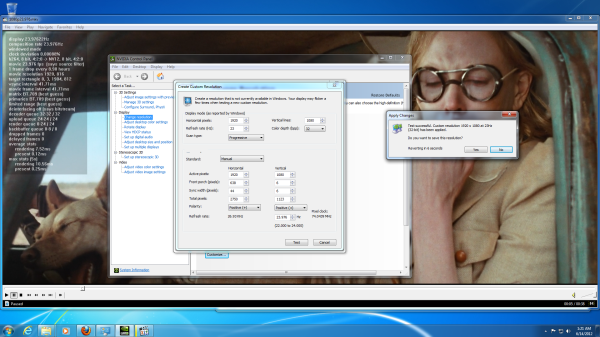Zotac GeForce GT 640 DDR3 Review: Glacial Gaming & Heavenly HTPC
by Ryan Smith & Ganesh T S on June 20, 2012 12:00 PM ESTHTPC Aspects : Custom Refresh Rates
AMD and Intel GPUs don't offer the end users an easy way to create custom refresh rates for their displays. While Intel does offer a control panel for custom timings, it is heavily tied to the EDID, rendering it unusable for the most part. On the other hand, AMD GPUs have had a history of being close to the desired refresh rates out of the box. NVIDIA's GPUs have always needed some tweaking, and the Zotac GT 640 is no different.
As we have recounted in earlier HTPC reviews, a GPU should ideally be capable of the following refresh rates at the minimum:
- 23.976 Hz
- 24 Hz
- 25 Hz
- 29.97 Hz
- 30 Hz
- 50 Hz
- 59.94 Hz
- 60 Hz
Some users demand integral multiples of 23.976 / 24 Hz because they result in a smoother desktop experience, while also making sure that the source and display refresh rates are still matched without repeated or dropped frames. The gallery below shows the refresh rate handling for 24, 25 (x2 = 50 Hz), 29.97 (x2 = 59.94 Hz), 30 (x2 = 60 Hz), 50, 59.94 and 60 Hz settings.
The native 23 Hz setting, unfortunately, resulted in a 23.9724 Hz refresh rate.
However, with some custom timing setup, we were able to achieve 23.97622 Hz, which is off by just 0.000196 Hz. In my experience, this is the closest to the optimum refresh rate that I have ever achieved with a NVIDIA card.
The custom timing feature is usable, but not without its quirks. Adding a custom resolution is straightforward. Setting the vertical parameters to values similar to the ones in the screenshot above achieves desired results, but the 23 Hz resolution gets saved as 24 Hz. We already pointed out the details in our review of the GT 540M in the ASRock Vision 3D 252B. We hope NVIDIA fixes this annoying issue in one of the upcoming driver releases.


















60 Comments
View All Comments
HighTech4US - Wednesday, June 20, 2012 - link
At least hen the GT240 was released it came in both DDR3 and GDDR5.UNhooked - Wednesday, June 20, 2012 - link
I wish there was some sort of Video encoding benchmark. I have been told AMD/ATI cards aren't very good when it comes to video encoding.mosu - Thursday, June 21, 2012 - link
who told you that kind of crap ?Please check the internet.Rumpelstiltstein - Thursday, June 21, 2012 - link
Did this low-end offering really manage to pull off these kind of numbers? I'm impressed. Not something I would buy personally, but I would have no problems recommending this to someone else.Samus - Thursday, June 21, 2012 - link
DDR3....ruined a perfectly good chip.Deanjo - Thursday, June 21, 2012 - link
Noooooo! Come on, post some benchmarks as it is right now. Some of us do not want to wait for AMD to get their VCE in order. People have been waiting for VCE for months and there is no valid reason to hold off NVENC waiting for their competitor to catch up. When and if VCE support comes out then run a comparison then.
ganeshts - Thursday, June 21, 2012 - link
NVIDIA indicated that official NVENC support in CyberLink / ArcSoft transcoding applications would come in July only. Till then, it is beta, and has scope for bugs.Deanjo - Thursday, June 21, 2012 - link
So? That didn't prevent them benching trinity and it's encoding capabilities despite it all being beta there.http://www.anandtech.com/show/5835/testing-opencl-...
drizzo4shizzo - Thursday, June 21, 2012 - link
So... do these new cards still support HDTV 1080i analog signals for those of us who refuse to give up our 150lb 34" HDTV CRTs?ie. ship with a breakout dongle cable that plugs into the DVI-I port? If they don't ship with one can anyone tell me if they are compatible with a 3rd party solution? For it to work the card has to convert to the YUV colorspace. My old 7600gt *did* support this feature, but none of the new cards mention it...
Upgrading my TV also means buying a new receiver for HDMI switching to the projector, fishing cable in walls, and all manner of other unacceptable tradeoffs. Plus monay.
Thanks!
philipma1957 - Thursday, June 21, 2012 - link
I have a sapphire hd7750 ultimate passive cooled card.This card seems to be worse in every case except it is 1 slot not 2.
The passive hd7750 is 125 usd this is 110 usd.
I am not sure that I would want this until they make a passive version.